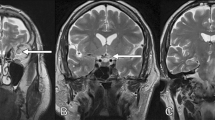Abstract
Internuclear ophthalmoplegia (INO) is a rare disorder of conjugate lateral gaze that has been described in a number of neurologic conditions including multiple sclerosis, stroke and less commonly brain tumors. We describe a series of 3 boys (11, 12, 15 years) diagnosed with primary central nervous system tumors (pilomyxoid variant astrocytoma, anaplastic oligoastrocytoma, gliomatosis cerebri) who developed bilateral INO as a manifestation of progressive disease. Time from diagnosis to development of bilateral INO ranged from 13–36 months. All children died of their disease 1–9 months following diagnosis of bilateral INO and had significant dorsal pontine invasion on magnetic resonance imaging at progression. Only one child had brainstem involvement at diagnosis. Our case series highlights this rare ophthalmologic syndrome of bilateral INO in association with tumor progression and provides a literature review of brain tumor associations with INO.


Similar content being viewed by others
References
Dolecek TA, Propp JM, Stroup NE, Kruchko C (2012) CBTRUS statistical report: primary brain and central nervous system tumors diagnosed in the United States in 2005–2009. Neuro-Oncol 14(suppl 5):v1–v49
Wilne S, Collier J, Kennedy C et al (2007) Presentation of childhood CNS tumours: a systematic review and meta-analysis. Lancet Oncol 8:685–695
Steinlin MI, Blaser SI, MacGregor DL, Buncic JR (1995) Eye problems in children with multiple sclerosis. Pediatr Neurol 12:207–212
Bolanos I, Lozano D, Cantu C (2004) Internuclear ophthalmoplegia: causes and long-term follow up in 65 patients. Acta Neurol Scand 110:161–165
Tomita T, Chou P, Reyes-Mugica M (1998) IV ventricle astrocytomas in childhood: clinicopathological features in 21 cases. Child’s Nerv Syst 14:537–546
Arnold AC (1990) Internuclear ophthalmoplegia from intracranial tumor. J Clin Neuroophthalmol 10(4):278–286
Keane JR (2005) Internuclear ophthalmoplegia: unusual causes in 114 of 410 patients. Arch Neurol 62:714–717
Okuda B, Tachibana H, Sugita M, Maeda Y (1993) Bilateral internuclear ophthalmoplegia, ataxia, and tremor from midbrain infarction. Stroke 23:481–482
Mueller C, Koch S, Toifl K (1993) Transient bilateral internuclear ophthalmoplegia after minor head-trauma. Dev Med Child Neurol 35:158–176
Ushio M, Iwasaki S, Chihara Y, Murofushi T (2008) Walled-eyed bilateral internuclear ophthalmoplegia in a patient with progressive supranuclear palsy. J Neuro-Ophthalmol 28:93–96
Menon V, Gogoi M, Saxena R, Singh S, Kumar A (2004) Isolated “One and a Half Syndrome” with brainstem tuberculoma. Indian J Pediatr 71(5):496–500
Korkmaz A, Topaloglu H, Kansu T (2002) Wall-eyed bilateral internuclear ophthalmoplegia in chronic demyelinating polyneuropathy. Eur J Neurol 9:691–692
Zlatescu MC, TehraniYazdi AR, Sasaki H, Megyesi JF, Betensky RA, Louis DN, Cairncross JG (2001) Tumor location and growth pattern correlate with genetic signature in oligodendroglial neoplasms. Cancer Res 61:6713–6715
Shin M, Nishihara T, Iai S, Eguchi T (2000) Benign aquaductal cyst causing bilateral internuclear ophthalmoplegia after external ventricular drainage. J Neurosurg 92:490–492
Gass A, Hennerici M (1997) Bilateral internuclear ophthalmoplegia in multiple sclerosis. J Neurol Neurosurg Psychiatr 63:564
Hughes TA, Wiles CM, Hourihan M (1994) Cervical radiculopathy and bilateral internuclear ophthalmoplegia caused by temporal arteritis. J Neurol 57:764–765
Misra AK, Mishra SK, Ortiz W (1994) Differential involvement of brainstem pathways due to forth ventricular epidermoid cyst: a case study. Clin Neurol Neurosurg 96:170–173
Sloane AE, Becker LE, Cyn Ang L, Wark J, Haslam RHA (1994) Neuronal intranuclear hyaline disease with progressive cerebellar ataxia. Pediatr Neurol 10:61–66
Crompton JL, Burrow DJ, Iyer PV (1989) Bilateral internuclear ophthalmoplegia- an unusual presenting sign of giant cell arteritis. J Ophthalmol 17(1):71–74
Cogen MS, Kline LB, Duvall ER (1987) Bilateral internuclear ophthalmoplegia in systemic lupus erythematous. J Neuro-Ophthalmol 7(2):69–73
Woody RC, Reynolds JD (1985) Association of bilateral internuclear ophthalmoplegia and myelomeningocele with arnold-chiari malformation, type II. J Clin Neuroophthalmol 5(2):124–126
Rosati G, Pinna L, Paolino E, D’Agostini G (1981) Reversible bilateral internuclear ophthalmoplegia due to head trauma: a case report. Eur Neurol 20:80–83
Chen CM, Lin SH (2007) Walled-eyed bilateral internuclear ophthalmoplegia from lesions at different levels in brainstem. J Neuro-Ophthalmol 27:9–15
Tekkok IH, Ayberk G, Kansu T, Suleyman S (1989) Bilateral internuclear ophthalmoplegia associated with fourth ventricular dermoid tumor. J Neuro-Ophthalmol 9(4):254–257
Netsky MG (1988) Epidermoid tumors: review of the literature. Surg Neurol 29:477–483
Schraeder PL, Cohen MM, Goldman W (1981) Bilateral internuclear ophthalmoplegia associated with fourth ventricular epidermoid tumor. J Neurosurg 54:403–405
Conflict of interest
The authors report no conflicts of interest.
Author information
Authors and Affiliations
Corresponding author
Additional information
Neggy Rismanchi MD PhD was responsible for drafting the manuscript for content, including medical writing, study concept and design, analysis and interpretation of the data. John Crawford MD MS was responsible for drafting the manuscript for content, including medical writing, study concept and design, analysis and interpretation of the data.
Rights and permissions
About this article
Cite this article
Rismanchi, N., Crawford, J.R. Bilateral internuclear ophthalmoplegia associated with pediatric brain tumor progression: a case series and review of the literature. J Neurooncol 115, 487–491 (2013). https://doi.org/10.1007/s11060-013-1250-z
Received:
Accepted:
Published:
Issue Date:
DOI: https://doi.org/10.1007/s11060-013-1250-z




